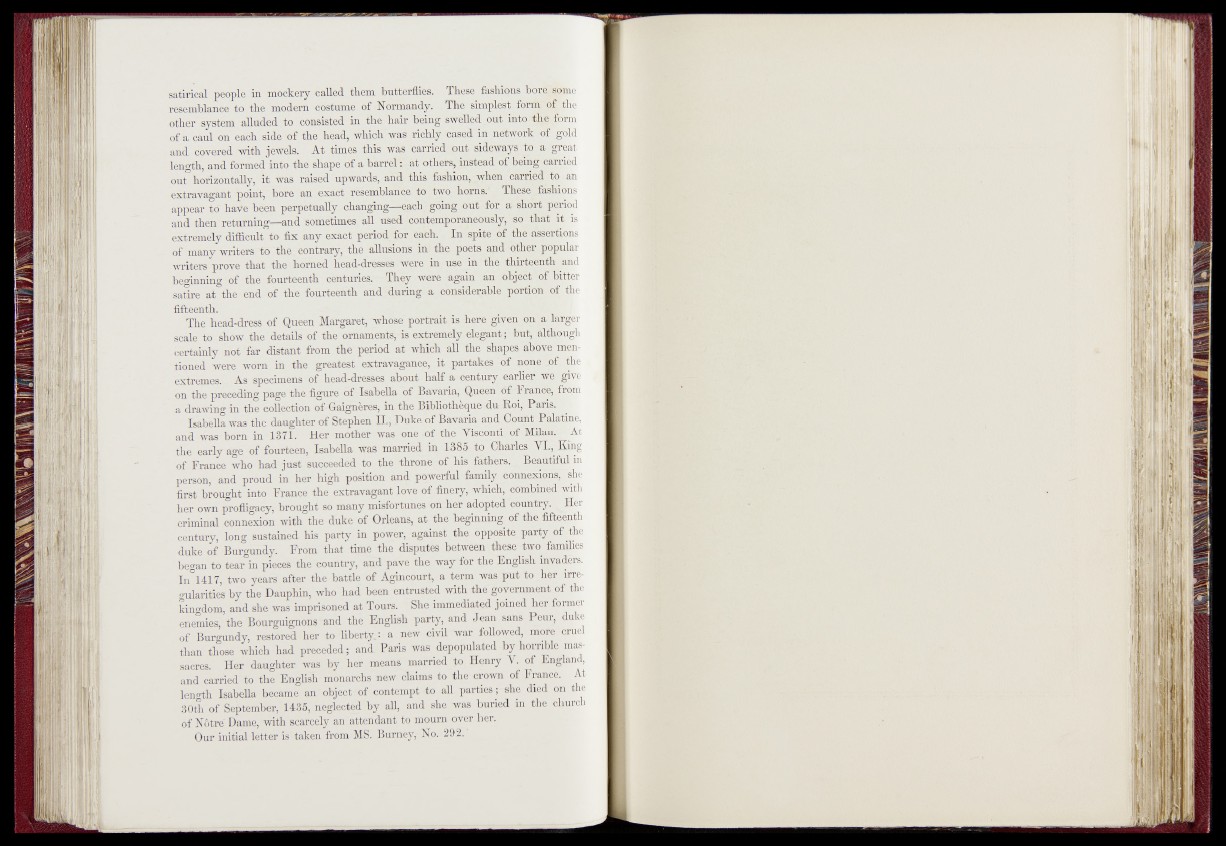
satirical peopled riöckery' cafredthem butterflies. These fashion,' g M » -
resemblance to the'modern costume, cfc^ormandy; . The";si4b].èlt form of the
other system alluded,"to consisted inU the hair being sj*eUcd-put_ into th^form
of a caul on each’side of the head, wlptjlT r il^ k h ïy , cased in network >(S||ld
and covered with jewels. At times this was- catried^intj;rid6ways.^^^^^^Kat
length, and formed into the shape of a barrel :^at‘b^fe,^ipstead'pf^^^^»ried
out horizontally, it was raised upwards, and this fashion, when carried: to/an
extravagant point,''bore an exact-resemblance, to.two froths?1 These^fashions
appear to’ have been perpetually changing^-r-each? going opt fof a -s^ ^ ^K io d
and then ' returning^—and 'somètimes. all uSed contetóporapeouslyitha t ilps
extremely difficult to fix any exact period for each; , Imspitè.of faeBBftfiora
of many writerS to 'the, contrary, the allusions in! the'’poets and-oth^;^ ular
writers prove that the horned head-dresses .were in use in^the tfrfrte^hthm id
beginning :of the fourteenth centuries^ They were again an .o b je c ^ ^ ^ u -r
satire at. the■ ehd-of the fourteenth and during a ^ c o n s i t e r a l o i j tin:
fifteenth. " - - ' ; h -. - \
The head-dress of Queen Margaret, whose portraitfis -here gh T
scale to show the details of the ornaments,-is extremely elegant jTouti^W^gh
cètamly not for distant from the period at wfrihfr' all thé sh a p c s^ ö ^ ^ E ri-
x tioned were worn in the greatest extravagance, it- par-talc
extremes. As specimens of head-dresses about half a-century eaj3ieg ^ M é
_ on the preceding page the .figure of Isabella of Bavaria, Q u eenllf^^^^^^pin
a drawing in tf»e collection of-Gaagnères, in the Bibüothèqjio duriiMgbaMr’^
Isabella was the daughter of Stephen II., Duke of Bavaria and Couf^i^latine,
and was born in 1371. -Her mother was4>ne *of the ^ « ^ n t ^ b ï - - ^ \ t
the earlyage of fourteen, Isabella was married in. 1385 to dJiarles VI., King
of France who had'just succeeded to the throne-of his fathers, y Bea ^M l m
person, and proud in her high position and, powerful fanuly^®i'xipTis. ■die
first brought into Ir^nce the extravagant love of ,£neiy, -which, uSnbnic dftirl.
her own profligacy, brought so many misfortunes on her adopted counti^Jföêr
criminal connexion with the duke of Orleans, at the beginning o f tm ^ e n t h
century, long sustained his party in power, against the opposite party of-the
duke of Burgundy. From that time the disputes between these two^ families
began to tear in pieces the country, and pave the w;ay for the English invaders.
In 1417, two years' after the battle of Agincourt, a term was put to>er|frre-
gularities by the DaUphin, who had been entrusted witfrthe'government c |:the
kingdom, and she was imprisoned at Tours. She immediated joined her: former
enemies, the Bourguignons and the English party, and Jean sans Feur, g s e
of Burgundy, restored her to liberty.: a new civil war followed, more Spiel
than those which had preceded; and Paris was depopulated by homblegas-
sacres. Hey daughter was by her means married to Henry V. of England,
and carried to the English monarchs new claims to the crown of France, At
length Isabella became an object-of contempt to all parties;-she died on the
30th of September, 4435, neglected by all, and she was buried in the church
óf Nótre Dame, with scarcely an attendant to mourn over her.
Our initial letter is taken from MS. Burney,-No.'292.'